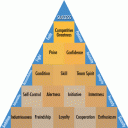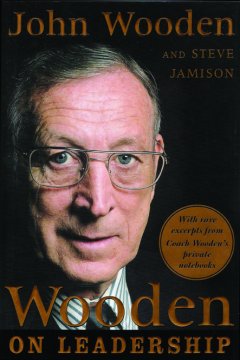John Wooden outlines his formula of leadership success in his book. As an UCLA alumni, I cannot help basting in his glory during his legendary tenure at UCLA. Although I started my schooling way after John Wooden’s years, the pride of the UCLA basketball stayed with the school and the students during all my years at UCLA. This may have pushed UCLA’s football to the forefront during my years at UCLA in the early ’80’s.
In any case, John Wooden exemplifies what a true leader should be. This book epitomize his teachings. The pyramid of success he outlines was truly an art.

On the bottom/foundation, there are:
A1) Industriousness (there is no substitute for work),
A2) Friendship (requires a joint effort),
A3) Loyalty (To yourself and to all those depending upon you),
A4) Cooperation (Be interested in finding the best way, not in having your own way)
A5) Enthusiasm (You must truly enjoy what you are doing).
Then the second layer of the pyramid:
B1) Self-control (Practice self-discipline and keep emotions under control),
B2) Alertness (Be observant and eager to learn and improve)
B3) Initiative (Don’t be afraid of failure but learn from it)
B4) Intentness (Being determined and persistent)
The third layer of the pyramid:
C1) Condition (Mental, moral, physical – moderation must be practiced)
C2) Skill (A knowledge of and the ability to execute the fundamental)
C3) Team Spirit (An eagerness to sacrifice personal interest for the welfare of all)
The fourth layer of the pyramid:
D1) Poise (Just being yourself)
D2) Confidence (Comes from being prepared and keeping proper perspective)
The Top layer:
E1) Competitiveness Greatness (Be at your best when your best is needed)
They sort of make sense and look nice to be form a pyramid. It would be nicer if it’s not that wordy or is condensed to 7~8 habits of the sorts. But they are all for good reasons as reinforced throughout the book. They also reflect how detailed-oriented a leader like John Wooden can and should be.
Coach Wooden went to a great length about how the leader must control his/her emotion in order to lead the team to the right goal. I certainly have a good feel of how important this is as people like to follow a cool-headed leader and yet show enough emotion to be human – a paradox that we want out of our leaders. I have seen first hand how much respect people pay to me when I encounter a difficult situation without knee-jerk reaction and yet with well-thought-out response. It’s hard to do and takes practice.
On how to manage your time, Wooden offers “make each day your masterpiece.” This is hard to do but may well be an over-arching goal for an individual. Given the high leverage of a leader to his/her organization, this is a critical step to move an organization forward. Often times, a leader must ask if this is be the best way to spend my time and how it contributes to the team goal. I’m taken aback how Wooden tracked and itemized the 2-hours practice time down to a 3″x5″ card – very disciplined indeed.
Wooden also suggested that the leadership shouldn’t look at the scoreboard. This goes hand in hand with achieving one’s success to the best of each person’s capability without comparing to others. It’s true that in a competitive business environment, one often falls into the trap of tracking market share. But it’s more important to ask if the BU has achieved all of what it’s capable with. What a mind set to achieve! Individually, one often keeps track one’s wealth as the scorecard and constantly compare to the “millionaire next door.” This is a trap John Wooden would like us to avoid.
Wooden is the kind of leader that sweat the small things to make big things happen. A leadership who doesn’t care enough to know the details often falls into the trap of missing the boat or steering an empty boat to nowhere. It’s refreshing to see a leader that’s truly down to earth. He also asks us to treat adversity is your asset, basically turning lemons to lemonade. And if one wants to reach all of his/her capability, adversity is a norm. How one handles or treat the adversity is how a person seizes the opportunity to learn from his/her mistakes and turn them into lessons for future success.
The one major take away for me is how he defines “success” in a person’s life. I struggled with this for myself until I read the following sentence from his book. “Success is peace of mind which is a direct result of self-satisfaction in knowing you made the effort to become the best of which you are capable.” How profound! It’s not how much money you have made, though having money may things a bit easier to achieve your success. It’s how much you have achieved that you’re capable of achieving. This sentence alone may well change how I plan my career.
I can see how all these skills are good for leading or coaching a basketball team or factory works but are they applicable to today’s highly independent, creative individuals as in an engineering organization? In other words, is the leadership model as described by John Wooden truly timeless and applicable to today’s knowledge workers? In my opinion, I believe so and I believe these qualities need to be taught to all the team members as all team members are leaders of their own areas of expertise.
Overall, it’s a great book. Thanks for sharing your leadership wisdom with us, Coach Wooden.


Hey! I just wanted to ask if you ever have any trouble with hackers?
My last blog (wordpress) was hacked and I ended up losing several weeks of
hard work due to no data backup. Do you have any
methods to protect against hackers?